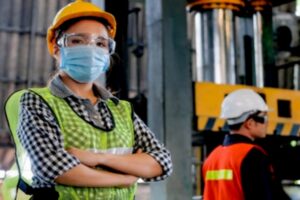Addressing Social Distancing in the Process Industry
- Essential industries need to operate during the pandemic to ensure critical supplies continue to reach the consumers.
- Process industries specifically Food & Beverages are a key link in this supply chain.
- Such industries need to operate implementing mandates to ensuring safety of their employees.
2020 has been a tumultuous year. The pandemic has significantly impacted daily livelihood across the world. Restricting spread of the virus requires key procedures be followed.
 Essential industries like Food & Beverage, and Chemical industries must continue to maintain production without having to compromise the safety of their employees. These industries have implemented various steps like daily temperature checks, adherence to sanitization, deep cleaning, etc. Despite this, we still hear about facilities or factories being shut down due to coronavirus cases.
CDC (1)/ OSHA (2)/ WHO (3) have industry mandates/ guidelines for every person at a workplace to maintain a safe distance to avoid contracting or spreading any form of infection. This is however not easy at a manufacturing facility. Each employee is working hard to complete their production goals and not run into their co-workers.
Essential industries like Food & Beverage, and Chemical industries must continue to maintain production without having to compromise the safety of their employees. These industries have implemented various steps like daily temperature checks, adherence to sanitization, deep cleaning, etc. Despite this, we still hear about facilities or factories being shut down due to coronavirus cases.
CDC (1)/ OSHA (2)/ WHO (3) have industry mandates/ guidelines for every person at a workplace to maintain a safe distance to avoid contracting or spreading any form of infection. This is however not easy at a manufacturing facility. Each employee is working hard to complete their production goals and not run into their co-workers.
 Essential industries like Food & Beverage, and Chemical industries must continue to maintain production without having to compromise the safety of their employees. These industries have implemented various steps like daily temperature checks, adherence to sanitization, deep cleaning, etc. Despite this, we still hear about facilities or factories being shut down due to coronavirus cases.
CDC (1)/ OSHA (2)/ WHO (3) have industry mandates/ guidelines for every person at a workplace to maintain a safe distance to avoid contracting or spreading any form of infection. This is however not easy at a manufacturing facility. Each employee is working hard to complete their production goals and not run into their co-workers.
Essential industries like Food & Beverage, and Chemical industries must continue to maintain production without having to compromise the safety of their employees. These industries have implemented various steps like daily temperature checks, adherence to sanitization, deep cleaning, etc. Despite this, we still hear about facilities or factories being shut down due to coronavirus cases.
CDC (1)/ OSHA (2)/ WHO (3) have industry mandates/ guidelines for every person at a workplace to maintain a safe distance to avoid contracting or spreading any form of infection. This is however not easy at a manufacturing facility. Each employee is working hard to complete their production goals and not run into their co-workers.
Proximity Tracing in such conditions is a logical choice to mitigate such risks.
Such an application will help employees cautiously maintain safe distance from each other without having to look around every time they walk around. Imagine a scenario where there are 15 people in a shift working on a line at different points from raw material mixing, producing, packing, storing and finally shipping. The process flows here run the risk of employees stepping across each other for various things. With the application in place, the person picking up raw materials from the warehouse can walk around and pick the material. If this person gets too close to another person within that section they would immediately get notified so they can stop and look around. From an Operations Manager perspective, this technology would ensure mandates are being adhered to. It would monitor the movements of people/ assets on the shop floor. It would raise alerts when social distancing norms are being breached. Data collected can further ne used to optimize current processes. This could be in the form of guided flows in moving around the floor ensuring social distancing. People could take their breaks systematically with minimal overlap and thus not crowd employee rest areas. The idea here is to reduce the effort of manually having a Shop floor inspector walk around policing personnel to maintain distance. This will now be managed seamlessly via triggers and notifications from a centrally managed real-time monitoring application. Analytics from such an application can help audit, produce audit reports for compliance and help track problem areas on the shop floor.
References:
- Guidance for Manufacturing Workers and Employers from the CDC: https://www.cdc.gov/coronavirus/2019-ncov/community/guidance-manufacturing-workers-employers.html
- Guidance on Preparing Workplaces for COVID-19: https://www.osha.gov/Publications/OSHA3990.pdf
- WHO’s country and technical guidance on COVID-19: https://www.who.int/emergencies/diseases/novel-coronavirus-2019/technical-guidance